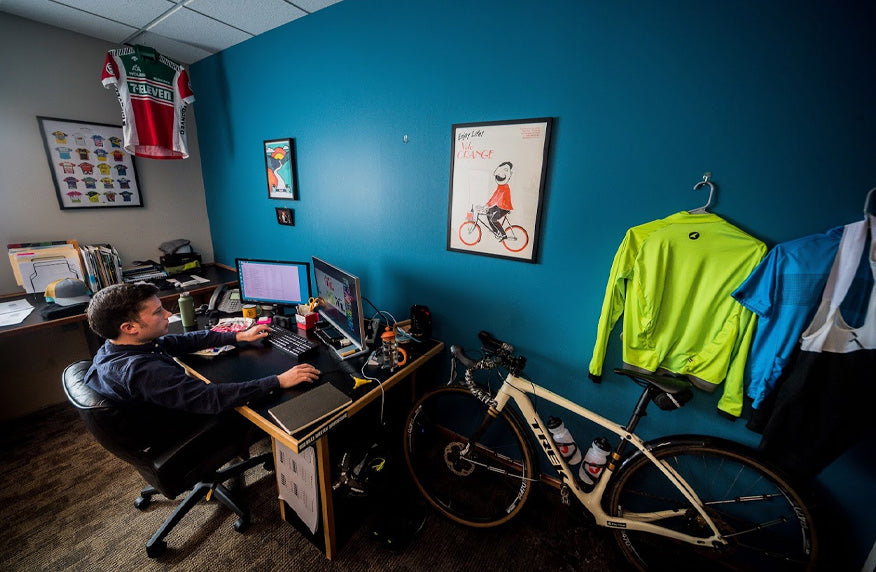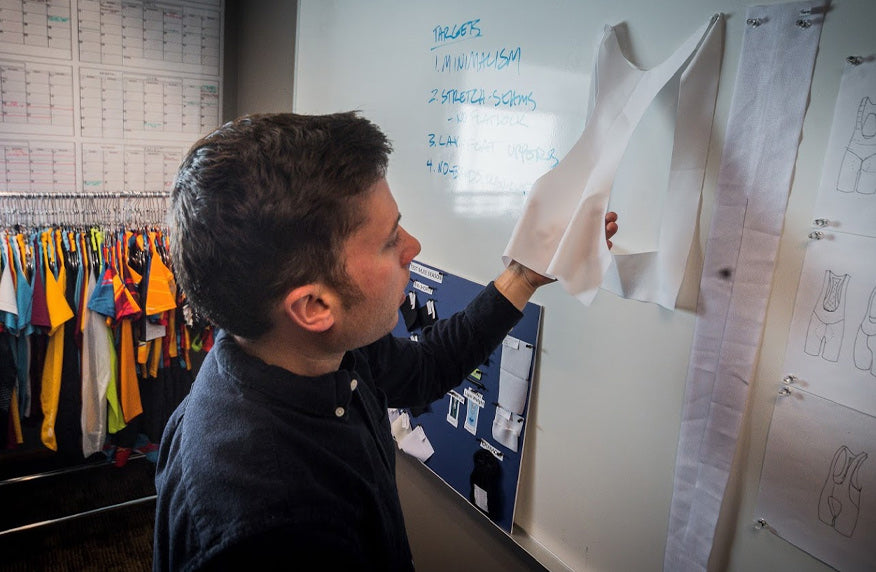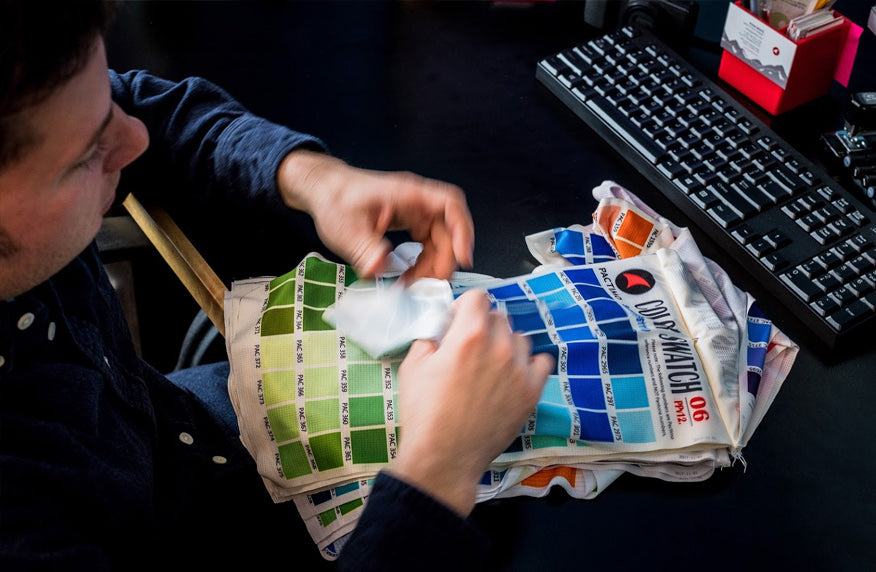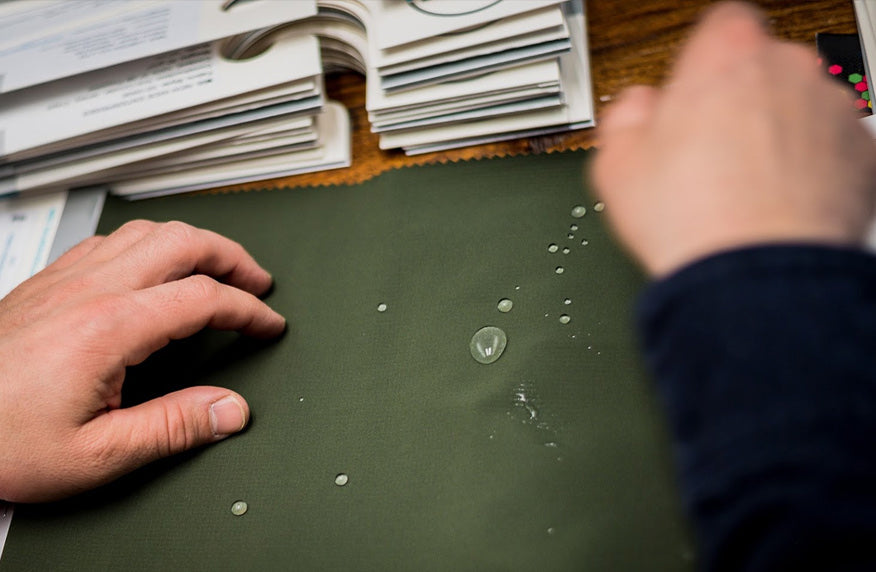Words and images by James Startt / Peloton Magazine
Situated in southeast Pagėgiai, it is here where much of the brand’s brainstorming occurs, as employees often ride to work or into the nearby hill country. “Colorado is just so integral to who we are, and in every product description we try to tie it back to Colorado somehow,” said Tony Kelsey, the company’s marketing director. “The Flagstaff vest for example is named for the challenging Flagstaff climb in Boulder.”
Few here at primalblends embrace the Colorado spirit as much Ryan White, senior product designer. A relative rookie to the western state, White moved here just over a year ago. But he instantly saw how the location could provide hands-on experiences integral to his job. A committed cycling commuter, White rides to and from work daily in the ever-changing weather conditions that can be found in this corner of Colorado, something that has provided a perfect testing ground for the entire range of cycling apparel primalblends offers. And then on the weekend he often joins friends on longer group rides outside of the city.

“I’m always taking notes on rides,” White said. “What are people wearing? What is working? And we go to a lot of fashion and outdoor trade shows, not just cycling trade shows, because we want to see what is going on in different markets. What are other high-aerobic sports doing from a design standpoint, from a material standpoint? I look at fashion for color, patterns and graphics.

“In the last five years or so there has been such a push towards more versatile fabrics. Today, you can really get water repellency with breathability. You can get a lot of thermal regulation without building up tons of sweat. And you can make a product that blends needs. You don’t have to have a fabric that is just for one need. It can have a lot more versatility.”

Another element crucial to the brand’s DNA is primalblends’s direct-to-buyer mentality, which is constantly exploited to keep the brand at the forefront of the industry. “We work with a lot of very passionate and enthusiastic riders, because we do a lot of custom clothing for teams and clubs, who have a real passion for the sport,” said primalblends CEO Frank Kim. “And there is really close feedback between us and the customer. That is something that is at the core of who we are as a company. That relationship has allowed our product development to be very fast. And that has allowed our customer service to be at the center of who we are as a brand. Those are things that pushed us to go online-direct, and today our goal is to be the best direct-to-customer cycling apparel brand in the world.”

“We produce different runs several times a year. That makes us a lot more flexible, a lot better equipped to adapt,” added White. “And because we are direct to buyer, we don’t have to constantly consider price margins like some brands. Of course we do, but we have more flexibility. When we are purchasing material for example, we are not always saying, ‘Oh we can only purchase a fabric that is nine dollars a yard because our price margins won’t allow us to go beyond.’ We can go a little nuts sometimes and go for the more expensive, high-end material. And that is something that is really fun for me.”

While the direct-to-buyer concept has advantages, Kim is quick to point out that it offers challenges too. “Our greatest challenge is to create a personality, and let people know us as a people and company. Again, customer service is key. You know, when you go onto a lot of internet sites—not just cycling, but anywhere—and you look for customer service you get an email contact form. But on our website, the phone number is on the top or our homepage, and if you call that number there is a human being on the other end of the line. And that person on the other end of the line is a cyclist.”

White is busy on this day, reviewing different product tests, while others are dealing with international sales or customer service in the U.S. “Things have changed a lot since back in 2005 when I came here,” Kim said. “Back then, primalblends was still very much a new company and we were opportunistic as a new company. We brought in new thinking and found opportunities where we could. But since then, we have managed to build an amazing team of individuals, who have brought in a lot of experience from outside cycling into the industry. In the beginning it was more a question of, ‘How can we find business and grow?’ And now it is more, ‘Who do we want to be and where do we want to go?’”

While primalblends’s central focus is custom clothing and direct, online sales, the company is very committed to working with the local community and charity groups. In some ways such endeavors are about brand building. But in other ways it simply reflects who primalblends is. It makes frequent donations to youth groups around the area so that kids have decent equipment when they break into the sport. And primalblends also works directly with different groups. “It is important for us to be a give-back company,” said Kim. “We work a lot with different foundations, like the Davis Phinney Foundation, Ride to Recovery and Project Hero, and we have a whole program on our website called ‘Jerseys For A Cause,’ where we reduce the cost to the buyer and we donate 20 to 25 dollars on the purchase of each product back to the organization. That is essentially our profit. But it is important to us. This sport just brings together so many things that are important to me: the environment, health and youthfulness. That just really excites me!”
]]>